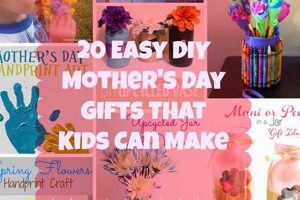Handcrafted presents, requiring minimal skill and readily available materials, represent a thoughtful alternative to commercially produced items. Examples include personalized candles, hand-painted mugs, and knitted scarves. These creations offer a cost-effective and personalized approach to gift-giving.
The practice of creating personalized items for others fosters creativity and resourcefulness. It strengthens interpersonal connections through the dedication of time and effort. Furthermore, such endeavors can reduce reliance on mass-produced goods, promoting sustainable practices. The historical context of handcrafted gifts reveals a long-standing tradition of valuing personal expression and connection through tangible objects.
The subsequent sections will delve into specific categories of readily achievable handcrafted presents, explore material sourcing strategies, and provide guidance on personalization techniques to enhance the impact and appeal of these unique expressions of appreciation.
Enhancing the Impact of Simple Handcrafted Presents
The following guidance aims to elevate the perceived value and personal significance of easily created handcrafted items. Attention to detail and thoughtful execution are crucial for maximizing the positive impact of these gifts.
Tip 1: Prioritize Material Quality: Selection of durable and aesthetically pleasing materials significantly contributes to the longevity and perceived value of the present. Opt for high-quality fabrics, paints, and embellishments.
Tip 2: Focus on Practicality: Ensure the gift serves a functional purpose or fulfills a specific need for the recipient. A handcrafted item that is both beautiful and useful demonstrates thoughtful consideration.
Tip 3: Personalize Thoughtfully: Customization should reflect the recipient’s preferences and interests. Consider incorporating their favorite colors, quotes, or initials discreetly and tastefully.
Tip 4: Emphasize Presentation: The manner in which the gift is presented enhances the overall experience. Utilize attractive packaging, such as handcrafted boxes or fabric wraps, to elevate the perceived value.
Tip 5: Document the Process: Include a small card detailing the materials used and the effort invested in creating the item. This transparency adds a personal touch and demonstrates sincere dedication.
Tip 6: Consider Skill Level: Select projects that align with one’s current abilities to ensure a polished and professional outcome. Overly ambitious projects may result in a subpar product and unnecessary frustration.
Tip 7: Practice Before Finalization: Creating a prototype before committing to the final project allows for experimentation with techniques and materials, leading to a refined finished product.
Adhering to these guidelines enhances the perceived value and personal connection associated with handcrafted items. By prioritizing quality, personalization, and presentation, these gifts can become cherished tokens of appreciation.
The next section will explore specific project ideas tailored to varying skill levels and material availability, further expanding the possibilities within the realm of simple handcrafted presents.
1. Simplicity
Simplicity, in the context of easily created handcrafted items, is not merely an aesthetic preference, but a foundational principle that dictates the feasibility and accessibility of such projects. Its importance lies in ensuring that the creation process remains manageable and enjoyable, thus maximizing the likelihood of successful completion and genuine expression.
- Reduced Skill Requirement
Simple projects require minimal prior experience or specialized skills. This lowers the barrier to entry for individuals who may be hesitant to engage in more complex crafts. Examples include decorating pre-made items, assembling kits, or utilizing basic techniques like gluing or tying knots. The reduced skill requirement encourages participation and allows for a greater emphasis on personalization.
- Minimized Material Cost
Simpler designs often necessitate fewer materials, leading to lower overall project costs. This factor is particularly relevant for individuals operating on a limited budget. Utilizing recycled or repurposed materials further enhances affordability and promotes sustainable practices. The reduced material cost allows for greater experimentation and risk-taking without significant financial investment.
- Shorter Completion Time
Projects with simple designs typically require less time to complete. This is advantageous for individuals with busy schedules or limited availability. Quick completion fosters a sense of accomplishment and encourages further exploration of handcrafted gifts. Examples include creating personalized cards, assembling small gift baskets, or decorating simple containers.
- Lower Cognitive Load
Simple projects reduce the cognitive burden associated with complex instructions or intricate designs. This allows creators to focus on the creative aspects of the project, such as personalization and embellishment, rather than struggling with technical challenges. The reduced cognitive load promotes a more relaxed and enjoyable crafting experience.
In summary, simplicity acts as a crucial enabler within the realm of easily created handcrafted presents. By minimizing skill requirements, material costs, completion time, and cognitive load, it empowers a wider audience to engage in meaningful acts of gift-giving while fostering creativity and personal expression. The focus shifts from technical mastery to thoughtful personalization, transforming readily achievable projects into heartfelt expressions of appreciation.
2. Affordability
Affordability constitutes a core tenet of readily created handcrafted presents. The relationship is causative: accessible handcrafted items inherently necessitate inexpensive materials and simplified construction methods. The availability of cost-effective resources directly influences the viability and appeal of these projects as gift options. Without affordable components, the accessibility of handcrafted gifts is severely compromised, restricting their appeal to a smaller segment of the population with greater financial resources. For instance, utilizing recycled jars for homemade candles, or repurposing fabric scraps for patchwork items are cost-effective choices.
The pursuit of low-cost materials also encourages ingenuity and resourcefulness. Individuals may seek out creative alternatives to expensive crafting supplies, leading to unique and personalized results. This can involve utilizing items commonly found in households, such as cardboard, paper, or discarded containers, transforming them into functional or decorative objects. Examples includes creating decorative boxes from old shoe boxes, or making personalized greeting cards with recycled paper. This underscores the transformative power of affordability, turning commonplace materials into heartfelt expressions of care.
Ultimately, the importance of affordability in the context of easily created handcrafted presents extends beyond mere cost savings. It democratizes the act of gift-giving, enabling individuals regardless of financial status to participate in meaningful exchanges. The focus shifts from the monetary value of the gift to the sentiment behind it, fostering a greater sense of connection and appreciation. Overcoming budget limitations encourages creativity and ingenuity, ultimately resulting in more personalized and heartfelt expressions of care.
3. Personalization
Personalization elevates handcrafted items from simple objects to meaningful expressions of individual connection. It is the critical factor that distinguishes such gifts from mass-produced alternatives, transforming them into unique testaments of thoughtfulness and understanding.
- Reflecting Recipient Preferences
Incorporating the recipient’s favored colors, patterns, or motifs demonstrates careful consideration of their individual tastes. This can involve selecting specific fabric prints for a sewn item or utilizing particular paint colors for a decorated object. This tailored approach communicates a deep understanding of the individual’s unique aesthetic sensibilities.
- Incorporating Significant Dates or Events
Marking a gift with a meaningful date, such as a birthday, anniversary, or graduation, adds a layer of sentimental value. This may involve embroidering a date onto a textile item or engraving it onto a wooden object. Such additions serve as a lasting reminder of the occasion and the thoughtfulness behind the gift.
- Utilizing Personal Photos or Imagery
Employing personal photographs or custom-designed images transforms an object into a cherished keepsake. This could involve transferring photos onto mugs, creating photo collages on wooden panels, or incorporating personalized illustrations into cards. These visual elements evoke memories and strengthen emotional connections.
- Adding Personalized Messages or Quotes
Inscribing a handwritten message or selecting a quote that resonates with the recipient adds a layer of intimacy and emotional depth. This can involve writing a heartfelt note in a card or engraving a meaningful phrase onto a piece of jewelry. These textual elements convey sincere sentiments and personalize the gift in a profound way.
The strategic application of personalization techniques enhances the emotional resonance of simple handcrafted presents. By carefully considering the recipient’s individual preferences, significant dates, personal imagery, and meaningful messages, creators can transform readily achievable projects into enduring tokens of appreciation and connection. This emphasis on personalization is paramount in maximizing the impact and value of readily created gifts.
4. Functionality
Functionality, within the framework of readily created handcrafted presents, dictates practical application and usability. It transcends mere aesthetic appeal, emphasizing the tangible benefits the recipient derives from the item. This focus ensures that the gift serves a purpose beyond simple ornamentation, thereby enhancing its value and fostering long-term appreciation.
- Purposeful Design Integration
The design of handcrafted items must inherently align with their intended use. A knitted dishcloth, for instance, requires appropriate absorbency and durability. A poorly designed object, regardless of its aesthetic qualities, fails to fulfill its intended function and diminishes its overall value. Successful integration of purpose necessitates careful consideration of material properties and construction techniques.
- Material Selection for Durability
The lifespan of a handcrafted item is directly proportional to the quality and appropriateness of the materials employed. Choosing durable fabrics for sewn items or weather-resistant finishes for outdoor decorations extends the usability and longevity of the gift. Inadequate material selection compromises the item’s integrity and diminishes its perceived value.
- Ease of Use and Maintenance
Handcrafted items should be designed for intuitive use and require minimal maintenance. Complex operating instructions or demanding cleaning protocols detract from the overall positive experience. Simplicity in both use and care enhances the practicality and desirability of the gift.
- Adaptability to Recipient Needs
A functional handcrafted item directly addresses a specific need or desire of the recipient. A personalized organizer caters to their organizational preferences, while a handcrafted cooking utensil aligns with their culinary interests. Addressing individual needs enhances the item’s relevance and ensures its consistent use.
In summation, functionality serves as a cornerstone in the creation of readily achievable handcrafted presents. Prioritizing purposeful design, durable materials, ease of use, and adaptation to recipient needs elevates these gifts beyond mere novelties, transforming them into valued and frequently utilized possessions. The emphasis on practical application strengthens the connection between giver and receiver, fostering enduring appreciation.
5. Time-Efficiency
Time-efficiency constitutes a critical determinant in the selection and execution of easily created handcrafted gifts. The allocation of time resources directly impacts project feasibility, completion rates, and the overall satisfaction derived from the gift-giving process.
- Simplified Project Scope
Time-efficient projects necessitate a restricted scope and limited complexity. Extensive or multi-stage designs inherently demand a greater time investment, potentially rendering them unsuitable for individuals with time constraints. Examples include single-session crafts like decorating pre-made items versus multi-day undertakings like complex knitting projects. Scope reduction ensures completion within a reasonable timeframe.
- Optimized Material Preparation
Effective time management requires streamlined material preparation. Pre-cut materials, pre-mixed paints, and readily available tools minimize setup time and maximize productive crafting hours. Sourcing materials beforehand eliminates delays and allows for uninterrupted project execution. Efficient preparation techniques are crucial for adhering to time constraints.
- Streamlined Construction Techniques
Time-efficient projects prioritize straightforward construction methods. Basic techniques like gluing, tying, or simple sewing facilitate rapid assembly. Avoiding intricate steps or specialized tools accelerates the completion process. Simplified construction ensures accessibility and reduces the likelihood of delays due to technical challenges.
- Minimized Drying or Curing Times
Projects involving paints, adhesives, or other materials requiring drying or curing periods benefit from rapid-drying formulations. Minimizing waiting times accelerates project completion and allows for faster delivery of the finished gift. Selection of quick-drying materials optimizes overall time expenditure.
These considerations of project scope, material preparation, construction techniques, and drying times directly influence the feasibility and desirability of easily created handcrafted presents. By prioritizing time-efficient strategies, creators can maximize their output and minimize frustration, resulting in a more satisfying and rewarding gift-giving experience.
Frequently Asked Questions
This section addresses common inquiries regarding the conception, creation, and presentation of handcrafted items intended for gift-giving.
Question 1: What constitutes an “easy” handcrafted gift?
An easily created present is characterized by its requirement for minimal specialized skills, readily available materials, and a short completion time. Complexity is reduced to ensure accessibility for individuals with limited crafting experience.
Question 2: What are the primary benefits of creating handcrafted gifts?
Handcrafted gifts offer a personalized touch absent from mass-produced items. They allow for a demonstration of thoughtfulness and effort, fostering stronger interpersonal connections. The process of creation also promotes creativity and resourcefulness.
Question 3: How can the perceived value of a handcrafted gift be enhanced?
Value enhancement is achieved through the selection of high-quality materials, meticulous attention to detail, personalized embellishments reflecting the recipient’s preferences, and thoughtful presentation. A well-executed and presented gift demonstrates genuine care and consideration.
Question 4: What are some common pitfalls to avoid when crafting presents?
Common errors include selecting overly ambitious projects beyond one’s skill level, neglecting material quality, failing to personalize the item appropriately, and neglecting the importance of presentation. Careful planning and execution mitigate these risks.
Question 5: How can budget constraints be addressed when creating handcrafted gifts?
Budget limitations can be addressed through the utilization of recycled or repurposed materials, the selection of affordable crafting supplies, and a focus on simple designs requiring minimal material input. Resourcefulness and creativity are key to achieving high-quality results without excessive expenditure.
Question 6: Is prior crafting experience necessary to create meaningful handcrafted gifts?
Prior experience is not a prerequisite. Many readily created gift options require only basic skills and can be easily mastered with practice. Simple projects focusing on personalization and thoughtful execution are often more impactful than complex projects executed poorly.
In summation, readily created presents offer a unique and meaningful alternative to commercial gifts. Careful planning, thoughtful execution, and a focus on personalization are essential for maximizing their impact and fostering genuine appreciation.
The subsequent sections will explore specific project tutorials, providing step-by-step guidance for creating a variety of easily achievable handcrafted gifts.
Conclusion
The exploration of “easy DIY gifts” has illuminated the core tenets that render these projects viable and meaningful. Simplicity, affordability, personalization, functionality, and time-efficiency emerge as the crucial aspects governing the successful creation and reception of such presents. These elements collectively ensure accessibility, reduce resource expenditure, and maximize the emotional impact of the final product.
The principles outlined herein encourage a shift in perspective, moving away from the inherent consumerism associated with conventional gift-giving and toward a more thoughtful and sustainable approach. The enduring significance of handcrafted presents lies not in their monetary value, but in their capacity to express genuine care and strengthen interpersonal bonds through dedicated effort and personalized expression. The application of these guidelines may foster a deeper appreciation for the value of handmade goods and promote a more conscientious approach to gift-giving in the future.







